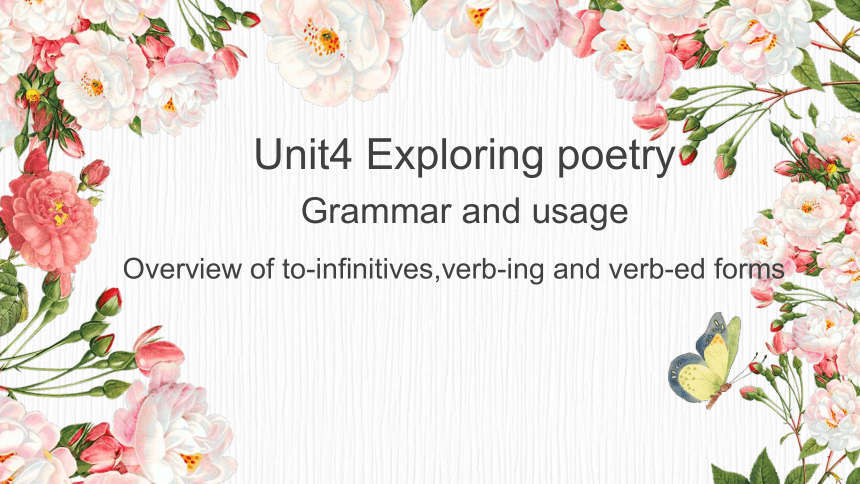(
课件网) Unit4 Exploring poetry Grammar and usage Overview of to-infinitives,verb-ing and verb-ed forms 04 Contents 05 不定式、动名词现在分词、过去分词作定语的区别 06 01 02 03 不定式、现在分词、过去分词作补语的区别 不定式、现在分词、过去分词作状语的区别 不定式和动名词作主语的区别 不定式和动名词作宾语的区别 不定式、动名词、现在分词、过去分词作表语的区别 Identify and categorize the use of to-infinitives, verb-ing and verb-ed forms; Summarize general rules of to-infinitives, verb-ing and verb-ed forms; 3. Use the right forms of to-infinitives, verb-ing and verb-ed forms to finish tasks such as rewriting sentences, completing an article and writing on the importance of reading poem. Lead-in 1. What are the main types of non-finite verbs 2. What can to-infinitives, verb-ing and verb-ed forms be used as in a sentence To-infinitives, verb-ing forms and verb-ed forms. They can be used as subject, predicative, object, attributive, adverbial and object complement. Exploring the rules Read the introduction on Page 48 and fill the table. Romanticism Definition It was a (1) _____ from the late 18th to the mod-19th century, evolving (2) _____ _____ and poets. Aim · To (3) _____ of the 18th century · To put emphasis on the importance of imagination and feeling, (4) _____ and a return to the past Representatives of English poets (5) _____ _____ Common theme in Romantic poetry Celebrating the beauty of (6) _____ Significance The poetry of the Romantic era is one of (7) _____. cultural movement painters, musicians, novelists break with the ideals the love of nature William Wordsworth, Samuel Taylor Coleridge, George Gordon Byron, Percy Bysshe Shelley nature and country life the greatest treasures in Western literature Go through the introduction and find the sentences that used to-infinitives, verb-ing or verb-ed forms and fill in the table. One has been done for you. Working out the rules The to-infinitive often refers to an action that will happen in the future; the verb-ing form, a continuing action; and the verb-ed form, a past action. Generally speaking, the verb-ing form expresses a(n) (1) _____ (active/passive) meaning, while the verb-ed form expresses a(n) (2) _____ (active/passive) meaning. active passive The to-infinitive can be used as the (3) _____ of a sentence. The verb-ing form can be used as the (4) _____ of a sentence. The verb-ed form can be used as the (5) _____ of a sentence. *You can choose more than one answer for each blank. a. subject b. predicative c. object d. complement e. attributive f. adverbial a, b, c, d, e, f a, b, c, d, e, f b, d, e, f 非谓语动词首先是一种动词形式,其次是这种动词形式不能单独做谓语 非谓语动词通常指to do、doing 和done 非谓语动词 1.什么是非谓语动词 意义 相同点 to do doing done 目的、将来、结果 主动、进行、修饰物 被动、完成、修饰人 1)有固定搭配 2)可以作表语、定语、状语、补语 一个句子当中,已经存在一个主句(谓语动词), 又没有连词的情况下, 还有别的动词出现时。 S ... ...

